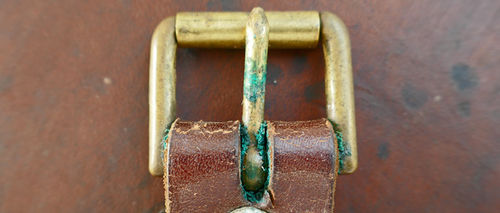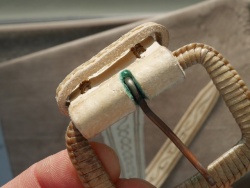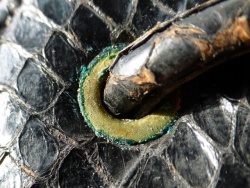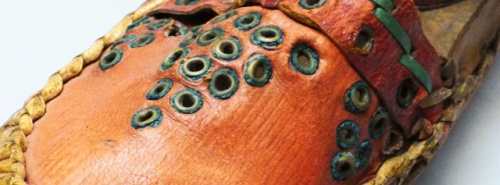Difference between revisions of "Corrosion"
(Created page with "<p align=center> 300px </p> <p align=center> 500px </p> '''Korrodierende Metallteile''' in Verbindung mit [...") |
|||
| Line 5: | Line 5: | ||
<p align=center> | <p align=center> | ||
| − | [[bild: | + | [[bild:Corrosion-leather-02.jpg|500px]] |
</p> | </p> | ||
| − | + | Corrosive metal parts in conjunction with leather are a common phenomenon that affects [[leather shoes|shoe]], [[Leather bag|bag closures]] as well as [[Leather belt|belt buckles]], rivets or buttons. Over time, the metal parts become dull, rust, change their colour or a coating peels off. There is rarely a single cause, since the speed and extent of metal corrosion can be directly attributed to several factors: | |
| − | * | + | * The alloying constituents and the method of processing the metal element (coating, surface treatment). |
| − | * | + | * The [[Types of leather|type of leather]], the [[finish]] and [[Tanning leather|tanning]] of the adjacent leather. |
| − | * | + | * The environmental conditions directly affecting both materials. |
| Line 26: | Line 26: | ||
</p> | </p> | ||
<p align=center> | <p align=center> | ||
| − | '' | + | ''Corrosion of copper: [[Leather belt|belt buckle]]. - Eyelet of a [[snakeskin]] bag. - Eyelets on the [[leather shoes|leather shoe]].''<br></p> |
<p> </p> | <p> </p> | ||
| − | + | According to investigations, there are leathers which can promote corrosion. [[Chrome tanned#Chrome-free leather - FOC = Free of Chrome|chromium-free tanned]] leathers are a risk. The exact mechanism has not yet been clarified. It is thought to be an interaction of acidity and chloride content in the leather. The slightest traces of sulphide compounds, such as those used in the [[Liming - Leather Tanning|liming process]], can blacken silver. This also applies to the effects of hydrogen sulphide and sulphur dioxide from the air. If these emissions are intensified by moisture (rain, but also sweat), the toxins are thus bound to the metal by moisture and the corrosion can accelerate significantly. | |
| − | + | If the metal parts have processing damages, they are more susceptible to corrosion. They may have been poorly prepared for later coating, which results in uneven application. | |
| − | + | In order to prevent corrosion, a [[leather quality|prevention control]] is required in the production process. | |
Revision as of 13:33, 17 December 2016
Corrosive metal parts in conjunction with leather are a common phenomenon that affects shoe, bag closures as well as belt buckles, rivets or buttons. Over time, the metal parts become dull, rust, change their colour or a coating peels off. There is rarely a single cause, since the speed and extent of metal corrosion can be directly attributed to several factors:
- The alloying constituents and the method of processing the metal element (coating, surface treatment).
- The type of leather, the finish and tanning of the adjacent leather.
- The environmental conditions directly affecting both materials.
Corrosion of copper: belt buckle. - Eyelet of a snakeskin bag. - Eyelets on the leather shoe.
According to investigations, there are leathers which can promote corrosion. chromium-free tanned leathers are a risk. The exact mechanism has not yet been clarified. It is thought to be an interaction of acidity and chloride content in the leather. The slightest traces of sulphide compounds, such as those used in the liming process, can blacken silver. This also applies to the effects of hydrogen sulphide and sulphur dioxide from the air. If these emissions are intensified by moisture (rain, but also sweat), the toxins are thus bound to the metal by moisture and the corrosion can accelerate significantly.
If the metal parts have processing damages, they are more susceptible to corrosion. They may have been poorly prepared for later coating, which results in uneven application.
In order to prevent corrosion, a prevention control is required in the production process.
Additional information












 a kotori web solution
a kotori web solution